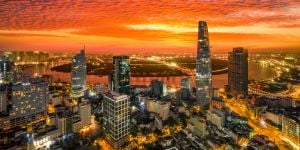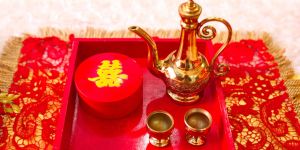Cho Lon Saigons Chinatown
Chinatowns flourish in many cities around the world, be it in the neon-glare of Londons Soho or along the streets of San Francisco. Vietnam too has a significant ethnic Chinese population, known as Hoa, half of whom live in Cho Lon Saigons Chinatown.
Cho Lon in the 1930s
Putting down roots
Cho Lon is west of downtown HCMC,annexing District 5 and neighbouring districts too. It was once a city in its own right, though. Chinese migrants mostly from Guangdong province began settling along Vietnams southern coast in the late 17th Century, first in a place now known as Bien Hoa.
An insurgent Tay Son army attacked them in 1778 for supporting the Nguyen Lords, who the Tay Son were fighting to depose. The Hoa were forced to abandon Bien Hoa, fleeing southwest to todays Cho Lon.The new settlement grew to the west of the Saigon River, taking the Chinese name Tai-Ngon meaning Embankment.
It is the 1930s, the French are in command, and Saigon has Cho Lon surrounded. The city was known for a while as Saigon-Cholon until rebranding relegated Chinatown to suburb status.
Modern day Cho Lon is an intense experience of sight, sound, taste and smell. Heady medicinal aromas drift from Hai Thung Lan Ong street, strawberry-red lanterns drip from store fronts, and Chinese food stalls fight to fill stomachs. And amid the hubbub, two attractions stand out: Binh Tay Market and Ba Thien Hau Pagoda.
Naming rights
Cho means Market and Lon is Big in Vietnamese. The name seems more than apt when confronted with the fizzy commerce bubbling within Binh Tay Market. Once Vietnams largest market, it totters on the edge of District 6, squeezed between the streets Thap Muoi and Phan Van Khoe.
The architecture is a fusion of Chinese tradition and French flair. Like a Russian doll, one elaborate roof begets another, smaller, while colonial France has dibs on the colour scheme: sunflower yellow as always.
Binh Tay Market started off life in what is now District 11 as a much smaller bazaar named Thi Ech Market. A wealthy Chinese entrepreneur named Quach Dam moved and extended the market in the 1920s, it becoming the two-floor building seen today.
Quach Dam led a classic rags-to-riches life and his bronze statue once stood at the centre of Binh Tay Market, surrounded by four dragons and four lions. The dragon and lion statues are still there, but now guard a glass altar dedicated to Quach Dam as his statue has moved to the citys Fine Arts Museum.
Inside the market, over two thousand stalls sell everything you could possibly want, and much more that you dont. Downstairs are piles of shrunken dried fish and upstairs floppy hats spill from the small stalls, narrowing an artery clogged with shoppers.
Curly and straight
Thien Hau is the Vietnamese name for the Taoist Goddess of the Sea, otherwise known as Mazu or Matsu.
People believe Thien Hau saves sailors from a watery grave and her legend was brought to Vietnam with itsfirst Chinese settlers. They thought Thien Hau had ensured them a safe voyage from their homeland and so a pagoda was built in thanks. Ba Thien Hau Pagoda (710 Nguyen Trai, District 5) was the result and is one of Vietnams earliest surviving places of worship.
Behind an ordinary metal gate is an extraordinary roof, along which everyday people conduct their once everyday life beneath the slithering bellies of two dragons. Unlike some neglected pagodas, Ba Thien Hau is full of life. Square red pillars line an open courtyard, spiral incense sticks strung across the sky.
The air is choked with wispy white smoke as hundreds of incenses sticks, curly and straight, burn leisurely. Hanging from each one is a piece of paper on which a prayer is written. Like Mission Impossible, the messages self-destruct as the incense burns to its tip, sending the prayer to the heavens.











